TBI Food Secrets: Unravelling the Fascinating History of the Samosa, India’s Favourite Street Snack
Here's the interesting history of the samosa, a well-travelled snack that happily settled in India and made the country fall head over heels in love with itself.

Most Indians think of the samosa as a humble street snack but it is much, much more than that. It is an historic symbol as well as delectable evidence that there is nothing new about the process of globalisation. Widely considered a quintessentially Indian delicacy, few people know that the samosa does not have an Indian origin. Yes, you read that right. The deep fried, tightly pack of spicy goodness that we thought belonged to India is actually a delicious and well-travelled immigrant from Central Asia!
Here’s the fascinating history of the samosa, a snack that happily settled in India and made the country fall head over heels in love with itself.

Photo Source
The samosa’s origins actually lie thousands of miles away in the ancient empires that rose up in the Iranian plateau at the dawn of civilization itself. The gastronomic literature of 10th century Middle Eastern cuisine, especially early medieval Persian texts have many mentions of the sanbosag, an early relative of the samosa and an etymological cousin of the Persian pyramidal pastry, samsa.
Other historical accounts also refer to sanbusak, sanbusaq and even sanbusaj as tiny mince-filled triangles, eaten by travelling merchants around campfires and packed in saddlebags as a snack for a long journey. According to these accounts, it was thanks to these travelling merchants that the stuffed triangle travelled from Central Asia to North Africa, East Asia and South Asia.
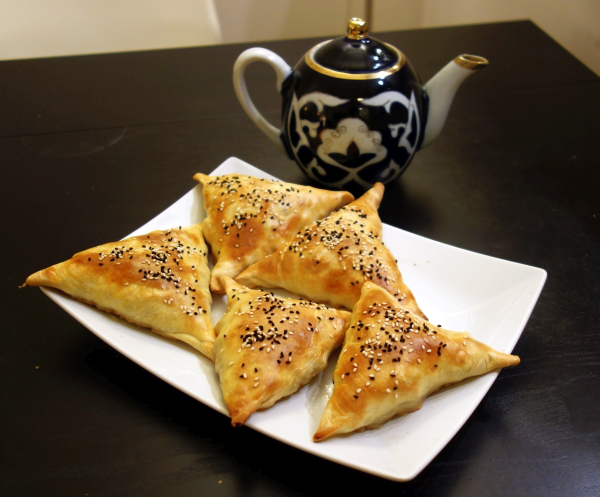
Photo Source
In India, it was introduced by the Middle Eastern chefs who migrated for employment during the Delhi Sultanate rule, although some accounts also credit merchants for bringing the fare to this part of the world. Later, having earned the blessings and love of the Indian royalty, the samosa soon became a snack fit for the king.
Ibn Batuta, the medieval Moroccan traveller who visited India in the 14th century, has chronicled the glittering banquets at the court of Muhammad bin Tughlaq. According to his accounts, a dish called sambusak — triangular pastry packed with mince, peas, pistachios, almonds and other tasty fillings — was placed on the guests’ plates right after the sherbet had been sipped. Other courses followed.
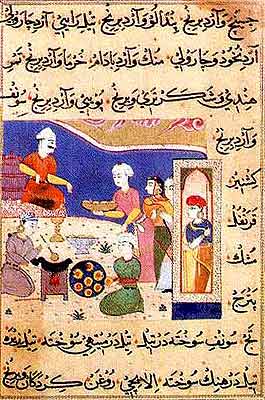
Photo Source
Likewise, Sufi scholar, musician and famed poet Amir Khusrau wrote of the samosa being enjoyed by nobles in the royal Indian courts in the year 1300. He famously framed the riddle:
“Samosa kyun na khaya? Joota kyun na pehna?
Talaa na tha.”[Translation: Why wasn’t the samosa eaten? Why wasn’t the shoe worn? The samosa wasn’t fried (talaa), the shoe didn’t have a sole (also called talaa.)]
Earlier still, a 9th century poem by Ishaq ibn Ibrahim-al-Mausili also celebrates the sanbusaj. Indeed, we have it on the authority of Abul Fazl, scholar-statesman extraordinaire, author of Ain-i-Akbari and one of the legendary nine gems of Akbar’s court, that the samosa was a dish relished by the Mughal Emperors.
You May Like: TBI Food Secrets: India’s Favourite South Indian Dish, Idli Sambar, Has Many Fascinating Legends
An interesting note here is the breadth of social classes making and eating the samosa, with the dish recorded in both trade routes and noble houses. The samosa proudly wore both the grand stamp of royal approval as well as the honest humility of being a snack of the streets. Herein lies a hint at the dish’s continued, unwavering popularity and success, even hundreds of years into its lifetime – its universality.
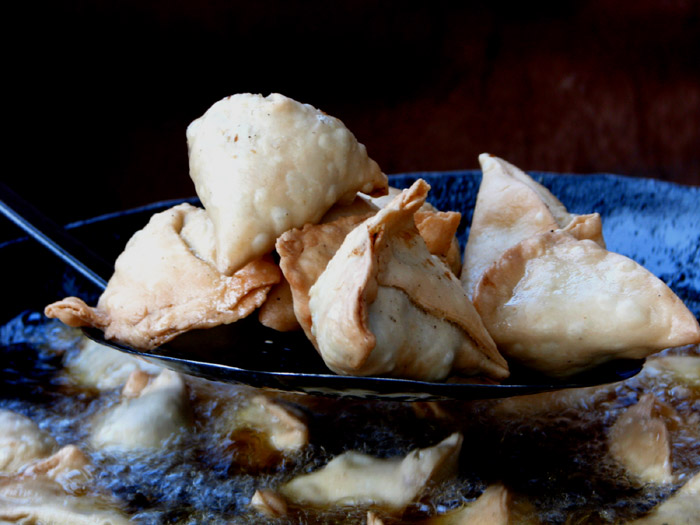
Photo Source
The Britishers too fell in love with the samosa on their arrival in India and they, along with the Indian diaspora, took the tasty tidbit with them to the far corners of their colonial empire. The samosa settled in the hearts of people everywhere, leading to the evolution of multiple regional versions.
In the Middle East, the semicircular version is stuffed with cheese, onions, herbs, spices and minced meat, and in case of Israeli cuisine, mashed chickpeas and pine nuts. Portugal and Brazil have meat-filled chamuças and pastéis; Uzbekistan and Kazakhstan has Uyghur-style samosas with a heavier bread dough and a lamb centre; Africa’s eastern Horn reserves sambusa for the local observations of Ramadan, Eid and Mesqel.

Photo Source
There are a number of varieties in India itself, all of them served with chutneys. According to samosa aficionados, a samosa is deemed perfect when crispy-crunch of the lightly golden casing contrasts beautifully with soft texture and spicy taste of the filling. The most popular and common filling is made of boiled potatoes, green peas, onions, green chilles, ginger and spices.
While the north Indian version of samosa is large, the version called the singhara (popular in West Bengal, Bihar, Odisha and Jharkhand), is smaller and has trickier folds. Also, the potatoes are cut fine (not boiled but cooked) and at times mixed with peanuts, the occasional raisin or the odd cashew nut. The Hyderabadi luqmi, on the other hand, is strictly meat-filled and far flakier than the regular samosa consumed elsewhere in India.

Photo Source Left/Right
In Karnataka, onion samosas is a big hit, as is keema samosa, made popular by some of the local bakeries. In Delhi, apart from the potato samosa, the one with keema, khova, or even moong dal are quite popular. The Punjabi samosa is dominated by potatoes and peas, with raisins and cashews added in to enhance the flavour, while in Gujarat, the patti samosa with a cabbage filling is quite popular.
There is also the samosa chaat, served with spicy chickpeas, sev and chopped onions. Another popular version is the mini cocktail samosa – dainty little things that are the perfect finger food to tuck into before dinner. The adventurous few have even forayed into seafood, pizza and chowmein samosas.
Then, there are those who like their samosas sweet. Labong latika (a Bengali sweet) is nothing but a mawa-packed samosa sealed with a clove. And, finally there are the baked samosas for the calorie-conscious. (Note: The baked versions are yummy but one keep yearning for a fried one while eating them!)
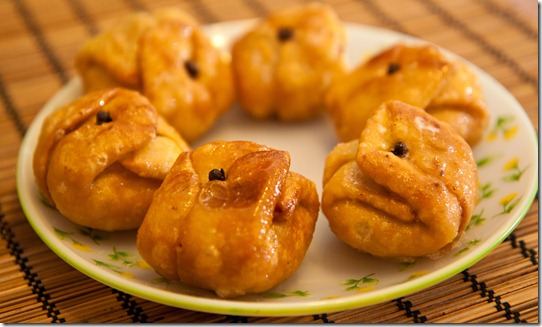
Photo Source
However it is filled and wherever it is prepared, the ubiquitous samosa embodies the essence of India – adaptable, inventive, tolerant and heterogeneous. Today, after centuries of evolution and adaptation, it has become arguably the most popular, plebian snack available in India.
There are few snacks that pair as perfectly with tea as samosa, and the chai-samosa combination is the national favourite when it comes to friendly addas, family gatherings, brainstorming sessions and heated political discussions. Each city has a shop that claims to serve the tastiest samosa in town. Some street-corners and crossroads have become famous merely because a samosa seller’s kiosk is located there. For instance, Loknath in Allahabad has built an enviable reputation on the strength of its ghee ke samose dal ki pithi wale.
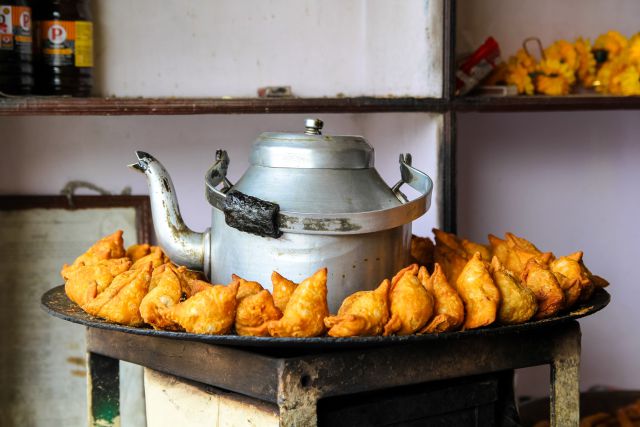
Photo Source
From college canteens to railway platforms and yes, airport lounges to food courts too, the samosa is omnipresent. A bunch of IITians have even dished out a social app called Samosa that aims to makes chatting fun. The Samosa app shares punchlines, proverbs, corny love messages, witty responses, funny expressions and song clips from popular movies. Asked what inspired them to choose this name, the founders answered,
“While we were brainstorming to choose a name, someone ordered samosas. We realised everyone eats samosa for chats and breaks and it was perfect as we wanted a name that was common and simple.”
The samosa is undoubtedly the brightest star in the constellation of Indian street food. When you bite into a gorgeous, golden samosa, what you taste is the story of India itself – a melting pot of cultures, cuisines and cooking traditions. Now that you know the fascinating history of this delightful dish, don’t forget to try making it at home. Here are the recipes for the best samosas – regular and with a twist. After all, this snack certainly needs no special occasion to be served on to your plates!
Also Read: TBI Food Secrets: The Fascinating History Behind Rajasthan’s Traditional Dish Dal Baati Churma
Like this story? Have something to share? Email: contact@thebetterindia.
NEW! Log into www.gettbi.com to get positive news on Whatsapp.
If you found our stories insightful, informative, or even just enjoyable, we invite you to consider making a voluntary payment to support the work we do at The Better India. Your contribution helps us continue producing quality content that educates, inspires, and drives positive change.
Choose one of the payment options below for your contribution-
By paying for the stories you value, you directly contribute to sustaining our efforts focused on making a difference in the world. Together, let’s ensure that impactful stories continue to be told and shared, enriching lives and communities alike.
Thank you for your support. Here are some frequently asked questions you might find helpful to know why you are contributing?


This story made me
-
97
-
121
-
89
-
167











